
Tra Bau fishing village (Làng chài Trà Báu)
Experience the unique charm of Tra Bau Fishing Village, with its vibrant stilt houses and immersive fishing life, nestled in breathtaking Ha Long Bay.
Nestled within the breathtaking Ha Long Bay, Dau Go Cave, or “Wooden Stakes Cave,” invites adventurers and history enthusiasts alike to explore its wondrous formations and rich cultural significance. As you step into this geological marvel, you are not just entering a cave but diving into a deep narrative of Vietnam’s heroic past and stunning natural artistry. The cave’s entrance looms large, promising a remarkable experience illuminated by both the gentle play of natural light and the deep shadows of centuries past. Each chamber unfolds like pages of a book, detailing the Earth’s complex geological processes. Whether you’re a seasoned traveler or a curious first-timer, Dau Go Cave is poised to leave an indelible mark on your journey.
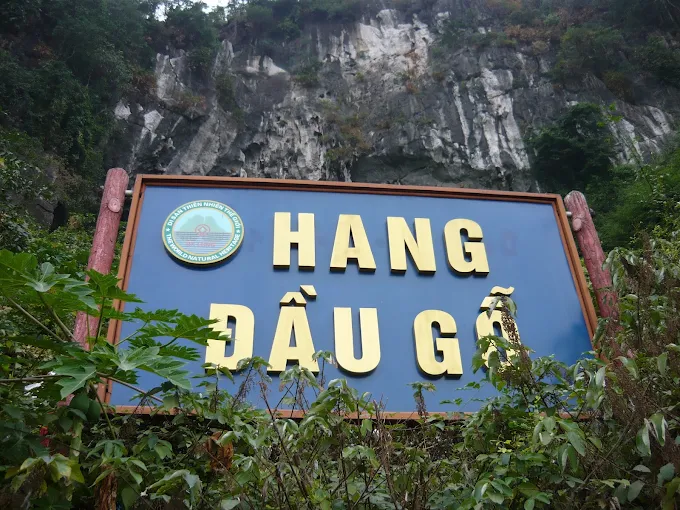
Dau Go Cave spans approximately 5,000 square meters, ranking among the most significant caves in Vietnam due to its intricate formations and historical relevance. The cave is structured into three distinct chambers, each revealing breathtaking stalactites and stalagmites that have formed over millions of years. The ambiance within the cave is a captivating combination of mystery, history, and natural beauty, making it a must-visit destination for both locals and international tourists.
The first chamber of the cave is particularly notable; it is illuminated by natural light that filters through the entrance, highlighting the myriad shapes and colors of the limestone formations. Visitors often remark that the stalactites here seem to resemble an exotic range of animals, creating a lively and imaginative atmosphere. The visual splendor of the first chamber sets a high standard, enticing visitors to venture deeper.
In contrast, the second chamber offers a more subdued environment, with strategic lighting enhancing the dramatic rock structures. This section of the cave is less illuminated, creating an ethereal setting that leaves visitors in awe of the natural artistry crafted over millennia. Here, the formations take on a mystic quality, drawing parallels to ancient deities or mythical beasts, depending on one’s perspective.
Finally, the third chamber provides a pleasant surprise: a freshwater well nestled among the formations. It is a rare feature found in caves and adds an element of intrigue to the overall experience. An exploration of this chamber typically concludes with visitors reflecting on the geological and historical importance of the site, deepening their appreciation for the natural world.
In summary, Dau Go Cave supports a rich interplay of history and geology that nicely complements the stunning scenery of Ha Long Bay. With its grand scale and unique formations, the cave effectively engages visitors, ensuring that their exploration will be memorable for years to come.
Dau Go Cave is situated on Dau Go Island, part of the spectacular Ha Long Bay, a UNESCO World Heritage site. Its prime location makes it easily accessible and an enticing destination for travelers seeking adventure and culture. The cave is approximately six kilometers from Bai Chay Tourist Port and just three kilometers from Tuan Chau Island, showcasing its central position within this famous bay.
Traveling to Dau Go Cave is a seamless experience, with several transportation options available. Many visitors opt for luxury cruise tours of Ha Long Bay, which often include a dedicated stop at the cave. Tour boats frequently depart from Bai Chay Tourist Port, allowing guests to marvel at the rocky islets and emerald waters that characterize Ha Long Bay during their journey. This scenic boat ride heightens the excitement of the cave visit, providing a beautiful backdrop that enhances the overall experience.
Alternatively, those seeking a more independent exploration can reach the cave via Tuan Chau Pier. Here, travelers can rent a traditional wooden boat or embark on a kayak expedition, immersing themselves in the natural surroundings along the way. This method of travel fosters a more personalized encounter with the area, offering unique vantage points for photography and more profound engagement with the local ecosystem.
Awareness of the cave’s proximity to other sites in Ha Long Bay can also inform your visit. For example, you can pair your trip to Dau Go Cave with visits to nearby attractions like Thien Cung Cave, which is renowned for its stunning stalactite formations, or to Bai Chay Beach for some relaxation after your exploration. With this range of accessible options, it becomes easy to craft a well-rounded itinerary that showcases the enchanting beauty of Ha Long Bay, all while ensuring that everyone from solo travelers to families can enjoy the adventure.
In conclusion, the location of Dau Go Cave on Dau Go Island, along with its excellent accessibility from major tourist hubs, solidifies its status as a premier destination amidst Vietnam’s awe-inspiring natural wonders.
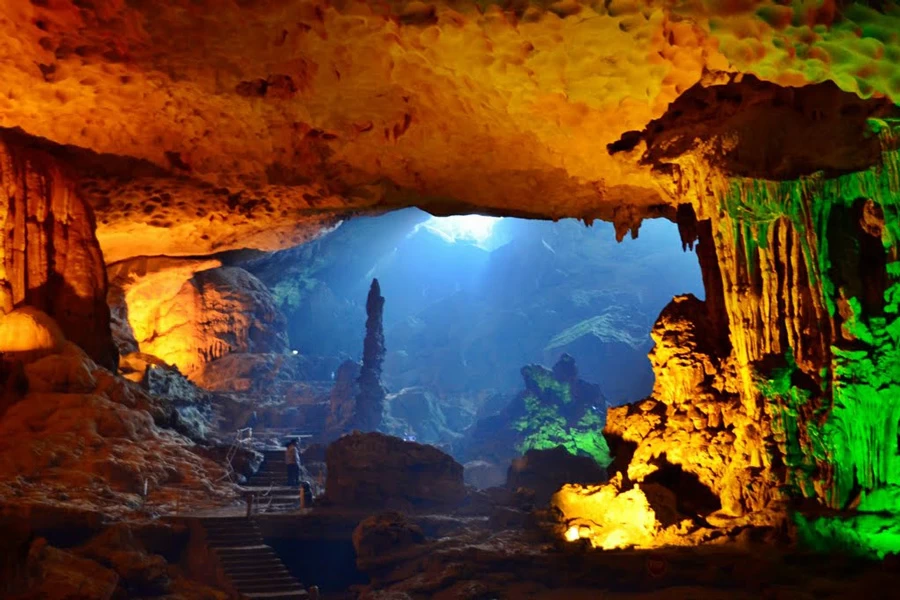
The historical significance of Dau Go Cave extends well beyond its breathtaking geological formations. It holds a vital place in Vietnam’s national narrative, particularly in connection with the heroic efforts against the Mongol invasions in the 13th century. The renowned General Tran Hung Dao and his troops utilized this cave as a strategic hideout for wooden stakes, which were then employed to thwart the Mongol fleet during their attempted invasions.
This legendary link transforms the cave into a symbol of resilience and bravery, encapsulating Vietnam’s rich martial heritage. The wooden stakes buried within the cave served a practical purpose and resonated with the spiritual fortitude that has defined the Vietnamese people throughout history. It is during times of challenge that this location stood as a bastion of hope and cleverness, showcasing how the natural landscape was intricately woven into military strategy.
Local celebrations of various legends imbue the cave with additional historical value. One such tale recounts how General Tran Hung Dao sought refuge in the cave, devising plans that would ultimately lead to a major Vietnamese victory that preserved the nation’s sovereignty. Such stories abound, heightening the allure of the cave as a site for cultural pilgrimage, where visitors come to connect with the past.
Visitors exploring Dau Go Cave often engage with informative plaques and guided tours that articulate the cave’s historical importance. These narratives encourage a more profound understanding of Vietnam’s enduring spirit of resistance and transformation. As guests marvel at the cave’s stunning formations, they are also reminded of the sacrifices made by ancestors, anchoring their experience in a rich tapestry of history.
In reflection, Dau Go Cave transcends mere geological wonder; it serves as a testament to Vietnam’s storied past and its triumph over adversity and illustrates how nature can play an integral role in shaping a nation’s identity.

Dau Go Cave is renowned for its distinctive geological features that showcase the magnificence of natural processes. The cave system is a splendid example of karst topography, formed through erosion over millions of years, displaying a wide variety of stalactites and stalagmites that create breathtaking visuals akin to nature’s own gallery.
Measuring around 5,000 square meters, Dau Go Cave features a series of geological formations that evolve from one chamber to the next. The formations in the first chamber showcase impressive stalactites that dangle from the ceiling like intricate chandeliers. These natural sculptures have developed through the slow accumulation of mineral deposits, with some even resembling various symbolic figures, offering opportunities for imaginative interpretation among visitors.
Moving into the second chamber, the presence of undulating rock structures adds to the cave’s dramatic appeal. The interplay of light and shadow enhances the viewer’s experience, as intricately lit stalagmites rise suddenly from the ground, evoking images of ancient columns supporting a hidden temple. The sheer scale and complexity of these formations underscore the significance of geological processes that shaped not just this cave but the entire Ha Long Bay region.
In the third chamber, the addition of a freshwater well provides an unexpected highlight. This rare feature among caves is not just captivating in a visual sense; it serves as a vital water source for the area’s ecosystem. The well adds to the cave’s ecological diversity, supporting various forms of life while further cementing its status as a unique geological wonder.
Engaging with such geological features offers visitors not just visual pleasure but also educational insights into the earth’s history. The formations serve as a record of climatic changes, as well as provide clues regarding the geological activity in the region over time.
In essence, Dau Go Cave is not merely a cavern; it is a significant geological marvel that reminds visitors of the dynamic forces shaping our planet and the artistically intricate landscapes that emerge from those processes.
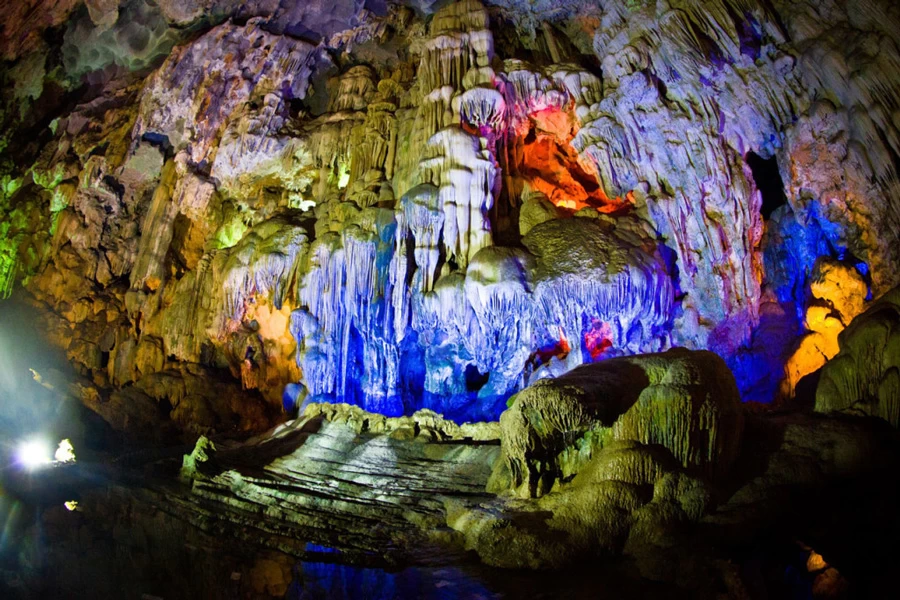
While Dau Go Cave is predominantly recognized for its stunning geological formations, it also showcases a rich tapestry of biodiversity thriving in its humid environment. The unique ecosystem within the cave provides a sanctuary for various species of flora and fauna, demonstrating the intricate relationship between geology and biology.
The cave’s conditions—darkness, high humidity, and consistent temperatures—support various plant life. You can see ferns, mosses, and other moisture-loving plants clinging to rock surfaces, adding an extra layer of charm to the already captivating environment. These species thrive in the cave’s microclimate, making it a focal point for botanical enthusiasts and researchers interested in cave ecosystems.
In terms of animal life, the cave is particularly known for being home to diverse bat species. These nocturnal mammals contribute significantly to pest control in the region and are fascinating subjects of study for those interested in ecology and wildlife. Observing bats in their natural habitat offers a unique perspective on cave ecosystems, highlighting the interconnectedness of life forms.
The cave’s structural complexity allows for various niches where different organisms can thrive. For example, some areas might be more conducive to the growth of certain plant species, while others might remain perfectly suited for roosting bats. This biodiversity makes Dau Go Cave a vital resource for ecological research, particularly in understanding how species adapt to unique environments.
Furthermore, the cave’s biodiversity enhances the overall visitor experience by providing a glimpse into the delicate balance of nature. As visitors traverse the chambers, they are encouraged to appreciate the living systems that coexist in these geological wonders. This collaborative existence highlights the importance of preserving such sites for future generations.
In summary, Dau Go Cave not only dazzles the senses with its geological beauty but also serves as a vital ecosystem, showcasing a rich diversity of life that exemplifies the intricate connections within the natural world.
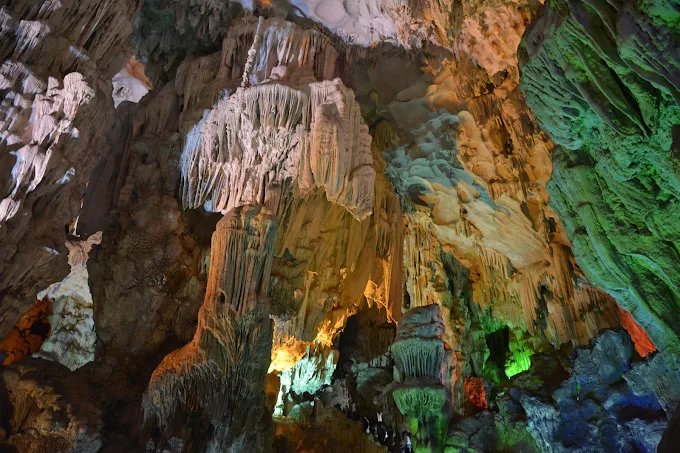
Dau Go Cave is surrounded by an array of nearby attractions that enhance the overall experience of visiting Ha Long Bay. Exploring these nearby sites allows travelers to fully immerse themselves in the region’s natural beauty and cultural heritage, making it an enriching journey.
One of the top attractions is Thien Cung Cave, located just four kilometers from Dau Go Cave. Known for its elaborate stalactite formations and mythical stories, Thien Cung Cave offers an equally mesmerizing experience. The cave is adorned with colorful lighting, which highlights its stunning features, creating an enchanting atmosphere for visitors. Many tour itineraries combine visits to both caves, allowing travelers to witness two distinct geological wonders in a single trip.
Another nearby destination is Bai Chay Beach, which is also approximately four kilometers away. This stunning beach offers a perfect contrast to the cave visits, with its sandy shores and beautiful views of the surrounding sea. Here, visitors can relax along the coastline, engage in water sports, or dine at local seafood restaurants, adding variety to their itinerary.
Tuan Chau Island, located around three kilometers from the cave, is another must-visit site. Known for its entertainment options and scenic landscapes, Tuan Chau boasts pristine beaches and luxurious resorts. Travelers can enjoy beach activities or explore the nearby attractions and cultural performances that paint a vibrant picture of local life.
For those looking for a family-friendly attraction, Sun World Halong Park is just a short distance away, approximately six kilometers. This theme park features amusement rides, cultural performances, and stunning views of Ha Long Bay. Perfect for families and thrill-seekers alike, Sun World offers a range of entertainment options, all while showcasing the beauty of the bay.
In conclusion, the proximity of these attractions to Dau Go Cave contributes significantly to the overall experience of visiting Ha Long Bay. By incorporating a diverse array of activities and sites, travelers can create a rich and fulfilling itinerary celebrating the area’s natural beauty and cultural vibrancy.
A visit to Dau Go Cave presents a unique blend of history, geology, and natural beauty, culminating in an unforgettable experience for all who venture inside. The cave’s grand entrance greets visitors, inviting them to ascend the 90 rocky steps leading to its mouth. The elevation at 27 meters above sea level provides breathtaking views of the surrounding landscapes, setting the stage for what lies within.
Once inside, guests are often struck by the cavernous space and its atmospheric ambiance. The first chamber, filled with natural light, showcases the stunning stalactites that hang from the cave ceilings. These striking features serve as eye-catching focal points, drawing the attention of visitors as they marvel at their beauty. Guides play an essential role in enhancing the visitor experience by sharing the cave’s fascinating history, providing insights into the formation of the geological features, and highlighting the importance of preserving such wonders.
While exploring the chambers, visitors can engage their imaginations by interpreting the various formations. Each unique shape inspires curiosity, encouraging discussions among small groups about what they resemble, from mythical creatures to majestic landscapes. This collaborative engagement adds an exciting layer to the experience, creating invaluable shared memories that last long after leaving the cave.
For safety and comfort, it is essential for visitors to wear non-slip shoes, allowing them to navigate the rocky terrain safely. Rushing through the cave could lead to accidents, so a pace that encourages careful exploration is encouraged. The humid climate within the cave can also surprise some, so it’s advisable to bring water and wear mosquito repellent to ensure comfort throughout the visit.
Finally, the unparalleled beauty of the cave beckons for photography, so guests should come prepared with fully charged devices to capture the stunning sights. Each chamber presents distinctive photo opportunities that guests will undoubtedly treasure as recollections of their adventures.
In summary, the visitor experience at Dau Go Cave is both exhilarating and educational, seamlessly integrating breathtaking natural artistry with a rich sense of history. Engaging with the space and each other enhances the adventure, ensuring all who visit leave with lasting memories.
When embarking on the adventure to Dau Go Cave, safety is paramount. This natural marvel, while stunning, presents certain challenges due to the rocky terrain and the humid environment. Visitors should take note of key safety measures to ensure an enjoyable experience while minimizing risks.
First and foremost, wearing appropriate footwear is essential. Non-slip shoes are highly recommended as they provide stability and grip when navigating the rocky steps and uneven surfaces. Flip-flops or sandals should be avoided, as they can increase the likelihood of slips and falls while exploring the caves.
Visitors should also be mindful of their pace while navigating through the cave. The formations, while breathtaking, can have sharp edges and protrusions that may pose risks. Taking a measured approach will enable guests to admire the beauty around them without the anxiety of bumping into fragile stalactites or stalagmites.
Moreover, preparing for the cave’s humid environment plays a significant role in ensuring comfort throughout the visit. We encourage guests to bring water bottles to stay hydrated and apply mosquito repellent before entering, as the moist conditions can attract insects. These simple precautions can significantly enhance the visitor experience, ensuring a comfortable exploration of this natural wonder.
Respect for the cave’s environment is also vital. Travelers should refrain from touching or climbing on the formations, as such actions can damage the delicate structures forged over millennia. Proper behavior ensures the preservation of the cave for future visitors, allowing generations to appreciate its natural beauty.
Owners of tour companies often highlight these safety tips during briefings before expeditions and stress the importance of adhering to the guidelines for a seamless experience. By practicing caution and respect for both the environment and fellow visitors, guests can fully immerse themselves in the awe-inspiring luminosity of Dau Go Cave.
The timing of your visit to Dau Go Cave can greatly influence the overall experience, with certain months offering more favorable weather conditions. The best periods to explore this geological wonder are from April to June and then again from October to December. During these months, temperatures are generally mild, and rainfall is minimal, allowing for comfortable navigation of the cave and the surrounding areas.
The peak tourist season typically occurs during the summer months of June to August. While this period attracts a vibrant array of visitors eager to enjoy the cooler climate of the bay, it can also lead to overcrowded conditions. Planning a visit outside of these peak months can make for a more tranquil experience, enhancing one’s ability to appreciate the cave’s beauty.
In contrast, visitors looking to explore other famous caves in Vietnam should note that each boasts its unique optimal visiting periods. For instance, Phong Nha Cave is best explored from January to August, aligning with its dry season, which allows for ideal conditions for exploration. On the other hand, Paradise Cave, part of the Phong Nha-Ke Bang National Park, can be visited year-round, though the dry months tend to be favored by tourists.
What makes Dau Go Cave stand out among these other natural wonders is its unique biodiversity and geological features. The cave enjoys a humid environment that supports a lens of different flora and fauna, something that may not be observed in the drier caves like Phong Nha and Paradise. Thus, the timing of your visit matters not only for climatic comfort but also for experiencing the stunning diversity and vibrancy of the cave’s ecosystem.
In conclusion, planning a visit to Dau Go Cave requires consideration of weather patterns and tourism cycles to maximize the enjoyment of one of Vietnam’s most celebrated natural spectacles.
When examining Vietnam’s extensive network of remarkable caves, Dau Go Cave stands out due to its unique characteristics and historical significance. While it shares some similarities with other renowned caves such as Phong Nha and Paradise Caves, it also presents distinct differences that enhance its appeal.
Dau Go Cave vs. Phong Nha Cave:
Dau Go Cave vs. Paradise Cave:
Ultimately, choosing to visit Dau Go Cave can enhance one’s understanding of Vietnam’s rich cultural and natural heritage, highlighting the diverse features that distinguish this cave from others in the country.
Dau Go Cave is a captivating destination that beautifully intertwines stunning natural beauty with rich historical significance. Nestled in Ha Long Bay, this enchanting marvel invites visitors to explore its mesmerizing formations, learn about its pivotal role in Vietnamese history, and appreciate the diverse biodiversity that flourishes within its chambers. Whether you are drawn by the allure of its geological artistry or the pervasive tales of resilience and courage, a visit to Dau Go Cave will undoubtedly leave you with lasting memories. It represents the artistry of nature and serves as a monument to a nation’s past, making it a must-visit for anyone exploring the wonders of Vietnam.

Experience the unique charm of Tra Bau Fishing Village, with its vibrant stilt houses and immersive fishing life, nestled in breathtaking Ha Long Bay.

Explore Bai Tu Long Bay’s stunning karst landscapes and serene waters for a memorable adventure.

Ha Long Bay is a mesmerizing masterpiece of nature, designated a UNESCO World Heritage Site, and a treasure trove of geological wonders and rich biodiversity.

Ba Trai Dao Islets is three small mountains, about 20m high, looking exactly like three peaches from afar. This place is associated with a legend about the romantic love between the beautiful, gentle youngest fairy and a poor fisherman.

Bo Hon Island is located right in Ha Long Bay, Quang Ninh Province. This place not only contributes to the beauty of Ha Long but also holds many mysteries that need to be discovered and learned when visiting the bay.
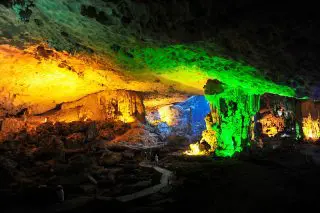
In the 1900s, the French came to explore Ha Long and discovered this cave. Because they were so amazed by the majestic beauty inside the cave, the name ‘La Grotte des Surprises’—The Amazing Cave, or Surprise Cave—was born. This cave on Bo Hon Island was also selected by CNN Travel magazine as one of the 7 most beautiful caves in Vietnam.

Hang Luon Ha Long, or Hang Luon Bo Hon, or Hang Luon on Bo Hon Island in Ha Long Bay, on the land of Ha Long City, Quang Ninh Province, Vietnam.

Incense Burner, is located southwest of Dau Go Cave, right next to Cho Da Islet. Currently, the 200,000 VND banknote features an image of the Incense Burner.
Copyrights @2025 Vietgo Travels. Terms and Conditions Privacy Policy
Hotline
+84 855 452 888 (Viet Nam) / +1 (206) 665 3090 (US)
Email: [email protected]
Website: www.vietgotravels.com
Head Office:
No. 23 Lo Su Street, Hoan Kiem District, Ha Noi, Viet Nam.
Viet Nam’s branch:
No. 35 Hang Quat Street, Hoan Kiem District,
Ha Noi, Viet Nam.
US:
831 41st Pl, Everett, WA 98201, USA